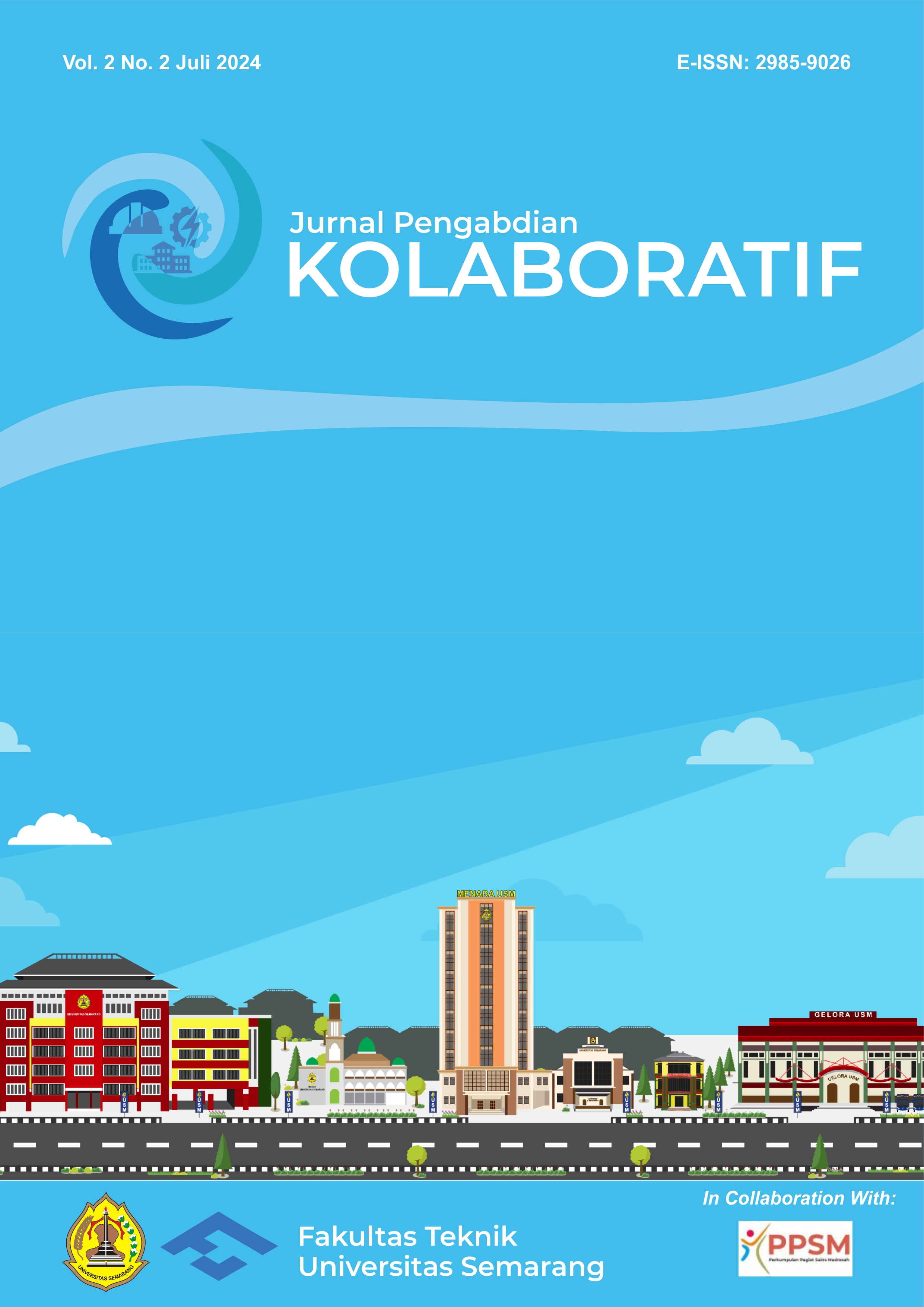Pelatihan Ecoprint dalam Mendukung Kreativitas Siswa Kelas 5 MI Tarbiyatus Shibyan
DOI:
https://doi.org/10.26623/jpk.v2i2.9619Keywords:
ecoprint, creativity, environmental pollutionAbstract
Ecoprint is a technique used to beautify fabric by utilizing natural materials. The ecoprint dyeing technique is simple, practical, easy to find materials for, environmentally friendly, and has artistic value. The lush environment of MI Tarbiyatus Shibyan, which is rich in various plants, supports the implementation of ecoprint training activities that can also enhance students' creativity. This activity aims to provide knowledge, train, and guide students in creating ecoprints to enhance their artistic creativity while reducing environmental pollution. The implementation method begins with providing material, training, and guidance in making ecoprints. The result of this activity is enthusiastic students expressing their creativity and imagination through environmentally friendly creations, which can be further developed and utilized to reduce environmental pollution in the surrounding area.
Downloads
References
Alam, S., Ramadhani, W. P., & Patmaniar, P. (2023). Pengembangan Lembar Kiagatan Siswa (LKS) Berbasis STEAM dengan Teknik Ecoprint Sebagai Perangkat Pembelajaran Tematik. Jurnal Pelita: Jurnal Pembelajaran IPA Terpadu, 3(1), Article 1. https://doi.org/10.54065/pelita.3.1.2023.318
Anugrah, H., & Zulfia Novrita, S. (2023). Penerapan Eco Print Daun Jati (Tectona Grandis) Pada Bahan Katun Menggunakan Mordan Tawas. Jurnal Pendidikan Tambusai, 7(2), 18364–18371. https://doi.org/10.31004/jptam.v7i2.9272
Clydesdale, F. (1997). Color: Origin, Stability, Measurement, and Quality. https://www.semanticscholar.org/paper/Color%3A-Origin%2C-Stability%2C-Measurement%2C-and-Quality-Clydesdale/02c40646344f78e9ab0cadfbc802e897f7196621
Hassaan, M., & El Nemr, A. (2017). Health and Environmental Impacts of Dyes: Mini Review. American Journal of Environmental Science and Engineering, 1, 64–67. https://doi.org/10.11648/j.ajese.20170103.11
Herlina, M. (2018, July 10). Eksplorasi Eco Printing untuk Produk Sustainable Fashion. https://www.semanticscholar.org/paper/Eksplorasi-Eco-Printing-untuk-Produk-Sustainable-Herlina/1877804f1ac1c74b4ba26f66ee196213bf47e6f6
Irianingsih, N. (2018). Yuk Membuat ECO PRINT Motif kain dari daun dan bunga. Gramedia Pustaka Utama.
Jackman, R. L., & Smith, J. L. (1996). Anthocyanins and betalains. In G. A. F. Hendry & J. D. Houghton (Eds.), Natural Food Colorants (pp. 244–309). Springer US. https://doi.org/10.1007/978-1-4615-2155-6_8
Kusumawati, E., Haryanti, U., Jayanti, K. D., & Safitri, E. I. (2024). Pemberdayaan Siswa Sekolah Dasar Al Islam 2 Jamsaren Surakarta Melalui Pelatihan Batik Ecoprint Untuk Meningkatkan Kreativitas Seni Siswa. PROFICIO, 5(2), Article 2. https://doi.org/10.36728/jpf.v5i2.3361
Listiana, H., Nashihatuddiniyah, Laili, E. S., Sutini, T. E., Alfiandi, U., & Setiadi, A. (2024). Eksplorasi Eco-Print Untuk Anak Sekolah Dasar Di Sdn Ponteh 1 Galis Pamekasan. MUBTADI: Jurnal Pendidikan Ibtidaiyah, 5(2), Article 2. https://doi.org/10.19105/mubtadi.v5i2.10670
Markakis, P. (1982). Anthocyanins as Food Additives. 245–253. https://doi.org/10.1016/B978-0-12-472550-8.50013-5
Metha, K. M. R., Susanti, R. A. D., Sulistiyowati, Y., Wicaksono, A. A., Irianti, N. P., Fidiastuti, H. R., & Lestari, A. W. (2023). Pelatihan Mengolah Motif Totebag Dengan Teknik Ecoprint Untuk Siswa Sd. Jurnal Pengabdian Kepada Masyarakat ITK (PIKAT), 4(2), Article 2. https://doi.org/10.35718/pikat.v4i2.866
Nurcahyanti, D., & Septiana, U. (2018). Handmade Eco Print as a Strategy to Preserve the Originality of Ria Miranda’s Designs in the Digital Age. Mudra Jurnal Seni Budaya, 33, 395. https://doi.org/10.31091/mudra.v33i3.543
Nurmasitah, S., Solikhah, R., Widowati, & Milannisa, A. S. (2022). The impact of different types of mordant on the eco-print dyeing using tingi (Ceriops tagal). IOP Conference Series: Earth and Environmental Science, 969(1), 012046. https://doi.org/10.1088/1755-1315/969/1/012046
Pandansari, P., Purwanti, R., & Alfianti, D. A. (2022). Analysis of Steaming Ecoprint Techniques on Various Fabrics. Formosa Journal of Social Sciences (FJSS), 1(4), Article 4. https://doi.org/10.55927/fjss.v1i4.2049
Rahayun, G. R., & Pamungkas, S. J. (2022). Efektivitas Pemanfaatan Ecoprint Sebagai Media Pembelajaran IPA Tema Peduli Terhadap Mahluk Hidup di Sekolah Dasar. Jurnal Basicedu, 6(5), Article 5. https://doi.org/10.31004/basicedu.v6i5.2405
Salsabila, B., & Ramadhan, M. S. (2018). Eksplorasi Teknik Eco Print Dengan Menggunakan Kain Linen Untuk Produk Fashion. eProceedings of Art & Design, 5(3).https://openlibrarypublications.telkomuniversity.ac.id/index.php/artdesign/article/view/7780
Saptutyningsih, E., & Wardani, D. T. K. (2019). Pemanfaatan Bahan Alami Untuk Pengembangan Produk Ecoprint Di Dukuh Iv Cerme, Panjatan, Kabupaten Kulonprogo. Warta LPM, 21(2), Article 2. https://doi.org/10.23917/warta.v21i2.6761
Savana, T., Mawarni, P. Y., & Ambarwati, Y. (2023). Pengenalan Kearifan Lokal Melalui Pelatihan Pembuatan Batik Ecoprint Pada Siswa Sekolah Dasar Sdn Pangur 1 Ngawi. Pendas : Jurnal Ilmiah Pendidikan Dasar, 8(2), Article 2. https://doi.org/10.23969/jp.v8i2.9340
Simanungkalit, Y. S., & Syamwil, R. (2020). Teknik Ecoprint dengan Memanfaatkan Limbah Mawar (Rosa Sp.) pada Kain Katun.
Suryani, H., & Megavitry, R. (2020). Pemanfaatan Bahan Alami Untuk Pembuatan Ecoprint Pada Peserta Kursus Menjahit Yayasan Pendidikan Adhiputeri Kota Makassar.
Downloads
Additional Files
Published
Issue
Section
License
This work is licensed under a Creative Commons Attribution 4.0 International License.






